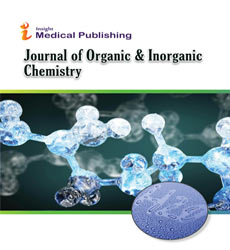Design and Synthesis of Novel Organometallic Complexes as Catalysts for Green Chemistry Applications
Jonathan Wells
Department of Organic Chemistry, University of Cambridge, Cambridge, United Kingdom
Published Date: 2025-02-28DOI10.36648/2472-1123.11.1.122
Received date: February 03, 2025, Manuscript No. ipjoic-25-20810; Editor assigned date: February 05, 2025, PreQC No. ipjoic-25-20810 (PQ); Reviewed date: February 17, 2025, QC No. ipjoic-25-20810; Revised date: February 22, 2025, Manuscript No. ipjoic-25-20810 (R); Published date: February 28, 2025, DOI: 10.36648/2472-1123.11.1.122
Citation: Wells J (2025) Design and Synthesis of Novel Organometallic Complexes as Catalysts for Green Chemistry Applications. J Org Inorg Chem Vol.11 No.1: 122.
Introduction
Green chemistry has emerged as a paradigm shift in chemical sciences, emphasizing environmentally sustainable, energy-efficient, and safer chemical processes. Central to this vision is the design of catalysts that minimize waste, enhance selectivity, and reduce hazardous byproducts. Organometallic complexes-hybrid compounds containing metal centers bound to organic ligands-play a pivotal role in catalysis, bridging the gap between traditional homogeneous and heterogeneous systems. Their tunable properties make them particularly attractive for advancing the goals of green chemistry. Catalysis represents one of the twelve principles of green chemistry, as it facilitates reactions under milder conditions while minimizing waste and energy consumption. Organometallic complexes excel in this regard due to their ability to stabilize reactive intermediates, lower activation energies, and promote atom-economical transformations. By tailoring ligand design and metal selection, chemists can fine-tune these complexes to achieve high efficiency and selectivity in diverse reactions, including hydrogenation, Câ??C coupling, and oxidation [1].
Description
Despite decades of progress, many traditional catalytic systems rely on expensive or toxic metals, such as platinum or palladium, and often require harsh reaction conditions. Novel organometallic complexes are designed to address these limitations by employing earth-abundant metals, eco-friendly ligands, and recyclable frameworks. The challenge lies in synthesizing complexes that not only perform comparably to noble metal catalysts but also align with the ecological and economic principles of sustainability. Ligands are central to modulating the electronic and steric properties of organometallic complexes. Advances in ligand engineering, such as the incorporation of N-Heterocyclic Carbenes (NHCs), pincer ligands, and bio-derived scaffolds, have expanded the scope of catalytic applications. These ligands enhance stability, solubility, and reusability, while enabling precise control over reaction pathways [2].
Transitioning from precious to base metals is another promising avenue. Iron, cobalt, nickel, and copper complexes have shown remarkable catalytic potential in hydrogenation, polymerization, and cross-coupling reactions. These metals are not only more abundant but also less toxic, thereby reducing environmental and economic burdens. Research is increasingly directed toward designing organometallic frameworks that harness the reactivity of these metals without compromising catalytic efficiency [3].
The synthesis of new organometallic complexes involves innovative methodologies that prioritize efficiency and sustainability. Techniques such as microwave-assisted synthesis, solvent-free methods, and mechanochemical approaches have gained traction for minimizing solvent waste and energy consumption. Additionally, modular synthetic strategies enable the rapid screening of ligandâ??metal combinations, accelerating the discovery of highly active green catalysts. Novel organometallic complexes have been successfully applied in several hallmark green reactions. Examples include catalytic hydrogenation using iron complexes, selective oxidation with manganese porphyrins, and carbon dioxide utilization via nickel-based systems [4].
These transformations highlight the potential of organometallic complexes to not only replace traditional catalysts but also open new avenues for valorizing renewable feedstocks and greenhouse gases. One major challenge in homogeneous catalysis is catalyst recovery and reuse. Advances in immobilizing organometallic complexes on solid supports, ionic liquids, or polymer matrices have addressed this limitation. These hybrid systems combine the activity of homogeneous catalysts with the recoverability of heterogeneous ones, enhancing sustainability. Magnetic nanoparticle-supported complexes, for instance, enable easy separation and repeated use without significant loss of activity. The synergy between organometallic catalysis and renewable feedstocks underscores their importance in future chemical industries. Despite remarkable progress, several challenges remain [5].
Conclusion
The design and synthesis of novel organometallic complexes represent a cornerstone of modern green chemistry. By integrating ligand engineering, earth-abundant metals, and sustainable synthetic techniques, chemists are crafting catalysts that align with ecological imperatives while maintaining industrial competitiveness. Continued innovation in this field promises not only cleaner and safer chemical processes but also a transformative impact on global sustainability efforts.
Acknowledgement
None.
Conflict of Interest
None.
References
- Neumann S, Biewend M, Rana S, Binder WH. (2020). The CuAAC: Principles, homogeneous and heterogeneous catalysts and novel developments and applications. Macromol Rapid Commun41: 1900359.
Google Scholar Cross Ref Indexed at
- Paier J, Marsman M, Kresse, G. (2007). Why does the B3LYP hybrid functional fail for metals?. J Chem Phys127.
Google Scholar Cross Ref Indexed at
- Meldal M, Tornøe CW. (2008). Cu-catalyzed azide− alkyne cycloaddition. Chem Rev108: 2952-3015.
Google Scholar Cross Ref Indexed at
- Jernei T, Duró C, Dembo A, Lajkó E, Takács A, et al. (2019). Synthesis, structure and in vitro cytotoxic activity of novel cinchona-chalcone hybrids with 1, 4-disubstituted-and 1, 5-disubstituted 1, 2, 3-triazole linkers. Molecules24: 4077.
Google Scholar Cross Ref Indexed at
- Srinivasan B, Johnson TE, Lad R, Xing, C. (2009). Structure− activity relationship studies of chalcone leading to 3-hydroxy-4, 3′, 4′, 5′-tetramethoxychalcone and its analogues as potent nuclear factor κB inhibitors and their anticancer activities. J Med Chem52: 7228-7235.
Open Access Journals
- Aquaculture & Veterinary Science
- Chemistry & Chemical Sciences
- Clinical Sciences
- Engineering
- General Science
- Genetics & Molecular Biology
- Health Care & Nursing
- Immunology & Microbiology
- Materials Science
- Mathematics & Physics
- Medical Sciences
- Neurology & Psychiatry
- Oncology & Cancer Science
- Pharmaceutical Sciences
